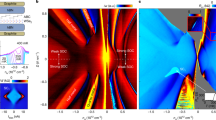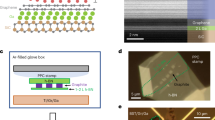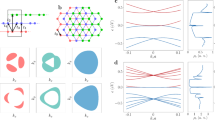Abstract
Superconductivity can be induced in a normal material via the ‘leakage’ of superconducting pairs of charge carriers from an adjacent superconductor. This so-called proximity effect is markedly influenced by graphene’s unique electronic structure, both in fundamental and technologically relevant ways. These include an unconventional form1,2 of the ‘leakage’ mechanism—the Andreev reflection3—and the potential of supercurrent modulation through electrical gating4. Despite the interest of high-temperature superconductors in that context5,6, realizations have been exclusively based on low-temperature ones. Here we demonstrate a gate-tunable, high-temperature superconducting proximity effect in graphene. Notably, gating effects result from the perfect transmission of superconducting pairs across an energy barrier—a form of Klein tunnelling7,8, up to now observed only for non-superconducting carriers9,10—and quantum interferences controlled by graphene doping. Interestingly, we find that this type of interference becomes dominant without the need of ultraclean graphene, in stark contrast to the case of low-temperature superconductors11. These results pave the way to a new class of tunable, high-temperature Josephson devices based on large-scale graphene.
This is a preview of subscription content, access via your institution
Access options
Access Nature and 54 other Nature Portfolio journals
Get Nature+, our best-value online-access subscription
$32.99 / 30 days
cancel any time
Subscribe to this journal
Receive 12 print issues and online access
$259.00 per year
only $21.58 per issue
Buy this article
- Purchase on SpringerLink
- Instant access to full article PDF
Prices may be subject to local taxes which are calculated during checkout



Similar content being viewed by others
References
Beenakker, C. W. J. Specular Andreev reflection in graphene. Phys. Rev. Lett. 97, 67007 (2006).
Efetov, D. K. et al. Specular interband Andreev reflections at van der Waals interfaces between graphene and NbSe2 . Nat. Phys. 12, 328–332 (2015).
Andreev, A. F. The thermal conductivity of the intermediate state in superconductors. Sov. Phys. JETP 19, 1228–1231 (1964).
Heersche, H. B., Jarillo-Herrero, P., Oostinga, J. B., Vandersypen, L. M. K. & Morpurgo, A. F. Bipolar supercurrent in graphene. Nature 446, 56–59 (2007).
Linder, J. & Sudbø, A. Dirac fermions and conductance oscillations in s- and d-wave superconductor-graphene junctions. Phys. Rev. Lett. 99, 147001 (2007).
Linder, J. & Sudbø, A. Tunneling conductance in s- and d-wave superconductor-graphene junctions: extended Blonder–Tinkham–Klapwijk formalism. Phys. Rev. B 77, 64507 (2008).
Katsnelson, M., Novoselov, K. & Geim, A. Chiral tunnelling and the Klein paradox in graphene. Nat. Phys. 2, 620–625 (2006).
Beenakker, C. W. J. Colloquium: Andreev reflection and Klein tunneling in graphene. Rev. Mod. Phys. 80, 1337–1354 (2008).
Huard, B. et al. Transport measurements across a tunable potential barrier in graphene. Phys. Rev. Lett. 98, 236803 (2007).
Young, A. F. & Kim, P. Quantum interference and Klein tunnelling in graphene heterojunctions. Nat. Phys. 5, 222–226 (2009).
Ben Shalom, M. et al. Quantum oscillations of the critical current and high-field superconducting proximity in ballistic graphene. Nat. Phys. 12, 318–322 (2015).
Klapwijk, T. M. Proximity effect from an Andreev perspective. J. Supercond. 17, 593–611 (2004).
Du, X., Skachko, I. & Andrei, E. Y. Josephson current and multiple Andreev reflections in graphene SNS junctions. Phys. Rev. B 77, 184507 (2008).
Ojeda-Aristizabal, C., Ferrier, M., Guéron, S. & Bouchiat, H. Tuning the proximity effect in a superconductor–graphene–superconductor junction. Phys. Rev. B 79, 165436 (2009).
Girit, Ç. et al. Tunable graphene dc superconducting quantum interference device. Nano Lett. 9, 198–199 (2009).
Komatsu, K., Li, C., Autier-Laurent, S., Bouchiat, H. & Guéron, S. Superconducting proximity effect in long superconductor/graphene/superconductor junctions: from specular Andreev reflection at zero field to the quantum Hall regime. Phys. Rev. B 86, 115412 (2012).
Sun, Q. J. et al. Electronic transport transition at graphene/YBa2Cu3O7-δ junction. Appl. Phys. Lett. 104, 102602 (2014).
Rickhaus, P., Weiss, M., Marot, L. & Schönenberger, C. Quantum Hall effect in graphene with superconducting electrodes. Nano Lett. 12, 1942–1945 (2012).
Deon, F., Šopić, S. & Morpurgo, A. F. Tuning the influence of microscopic decoherence on the superconducting proximity effect in a graphene Andreev interferometer. Phys. Rev. Lett. 112, 126803 (2013).
Allen, M. T. et al. Spatially resolved edge currents and guided-wave electronic states in graphene. Nat. Phys. 12, 128–133 (2016).
Wei, J. Y. T., Yeh, N.-C., Garrigus, D. F. & Strasik, M. Directional tunneling and Andreev reflection on YBa2Cu3O7−δ single crystals: predominance of d-wave pairing symmetry verified with the generalized Blonder, Tinkham, and Klapwijk theory. Phys. Rev. Lett. 81, 2542–2545 (1998).
Blonder, G. E., Tinkham, M. & Klapwijk, T. M. Transition from metallic to tunneling regimes in superconducting micro-constrictions—excess current, charge imbalance, and super-current conversion. Phys. Rev. B 25, 4515–4532 (1982).
Kashiwaya, S., Tanaka, Y., Koyanagi, M., Takashima, H. & Kajimura, K. Origin of zero-bias conductance peaks in high-Tc superconductors. Phys. Rev. B 51, 1350–1353 (1995).
Crassous, A. et al. Nanoscale electrostatic manipulation of magnetic flux quanta in ferroelectric/superconductor BiFeO3/YBa2Cu3O7−δ heterostructures. Phys. Rev. Lett. 107, 247002 (2011).
Bhattacharjee, S. & Sengupta, K. Tunneling conductance of graphene NIS junctions. Phys. Rev. Lett. 97, 217001 (2006).
Linder, J., Black-Schaffer, A. M., Yokoyama, T., Doniach, S. & Sudbø, A. Josephson current in graphene: role of unconventional pairing symmetries. Phys. Rev. B 80, 94522 (2009).
Cedergren, K. et al. Interplay between static and dynamic properties of semifluxons in YBa2Cu3O7−δ 0-π Josephson junctions. Phys. Rev. Lett. 104, 177003 (2010).
Bernard, A. Di et al. p-wave triggered superconductivity in single-layer graphene on an electron-doped oxide superconductor. Nat. Commun. 8, 14024 (2017).
Kidambi, P. R. et al. The parameter space of graphene CVD on polycrystalline Cu. J. Phys. Chem. C 116, 22492–22501 (2012).
Acknowledgements
Work at CNRS/Thales was supported by the French National Research Agency through ‘Investissements d’Avenir’ program Labex NanoSaclay (ANR-10-LABX-0035) and by the EU Work Programme under Grant Graphene Flagship (No. 604391) and Core1 (No. 696656). R.G. acknowledges funding from the Marie-Curie-ITN 607904-SPINOGRAPH. S.H. acknowledges funding from EPSRC grants EP/K016636/1 and EP/P005152/1. P.S. acknowledges the Institut Universitaire de France for a junior fellowship. We thank A. S. Mel’Nikov, J. Linder, J. Santamaría, S. Gueron and H. Bouchiat for useful discussions. We thank Y. Le Gall for assistance during ion irradiation.
Author information
Authors and Affiliations
Contributions
J.E.V. and P.S. conceived the experiments. R.B. fabricated the YBCO films. P.R.K., M.-B.M. and S.H. fabricated the graphene sheets. F.A.C., fabricated the devices, with contributions from D.P., B.D., R.G. and M.P.-B. F.A.C. performed transport experiments, with contributions of D.P. and C.M.-L. D.P. performed numerical simulations. The figures were prepared and the paper written by D.P., F.A.C. and J.E.V., with contributions from all the other authors. All of the authors participated in the discussion of the results.
Corresponding authors
Ethics declarations
Competing interests
The authors declare no competing financial interests.
Supplementary information
Supplementary information
Supplementary information (PDF 1722 kb)
Rights and permissions
About this article
Cite this article
Perconte, D., Cuellar, F., Moreau-Luchaire, C. et al. Tunable Klein-like tunnelling of high-temperature superconducting pairs into graphene. Nature Phys 14, 25–29 (2018). https://doi.org/10.1038/nphys4278
Received:
Accepted:
Published:
Issue date:
DOI: https://doi.org/10.1038/nphys4278
This article is cited by
-
Zero bias conductance peak related to spin triplet states in noncollinear magnetized graphene superconducting junctions
Scientific Reports (2025)
-
Induced superconductivity in hybrid Au/YBa2Cu3O7−x electrodes on vicinal substrates
Scientific Reports (2025)
-
Investigation of thermodynamic properties of bilayer graphene under dual gating with perpendicular magnetic field
Journal of Mathematical Chemistry (2025)
-
Observation of interaction-induced phenomena of relativistic quantum mechanics
Communications Physics (2021)
-
Unconventional superconductivity in magic-angle graphene superlattices
Nature (2018)



